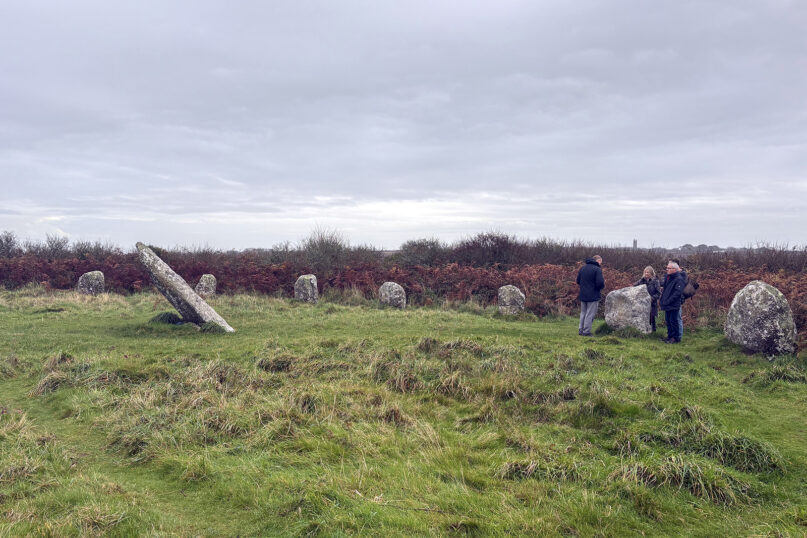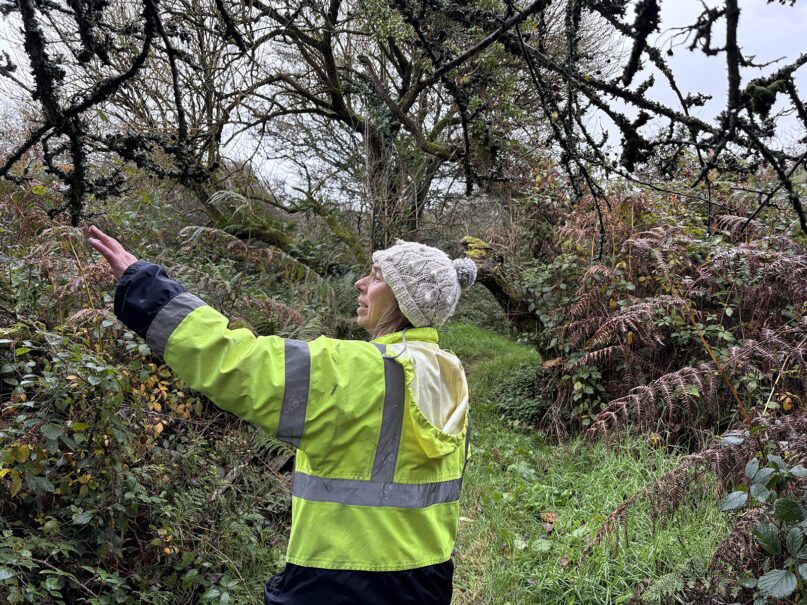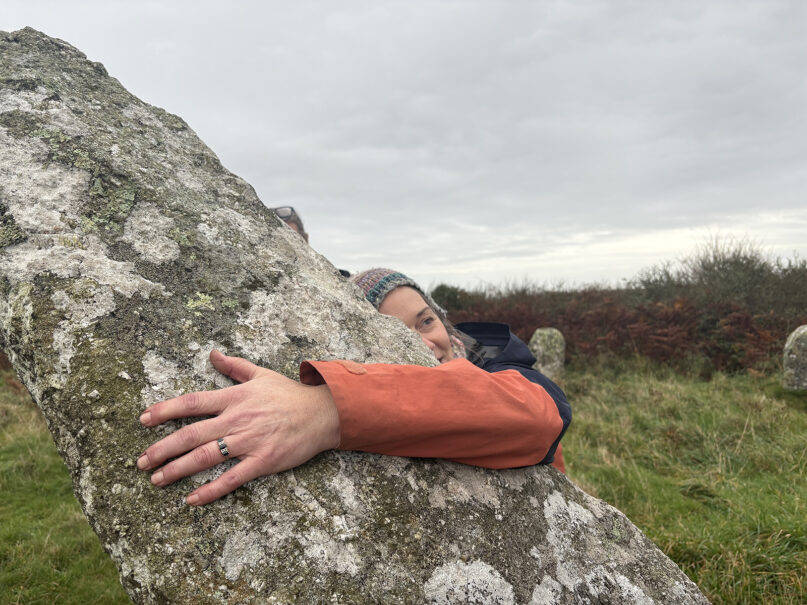PENZANCE, England (RNS) — On a gray fall afternoon earlier this month, a group of 19 people gathered outside the Church of St. Buryan, an iconic medieval parish with a 92-foot granite tower that dominates the skyline.
Clad in raincoats, reflective vests, waterproof boots with some holding wooden staffs, these residents of Cornwall, England’s coastal southwestern county, were ready for a different kind of spiritual experience — not in the church, but a stone circle.
Carolyn Kennett, an astronomer leading a 3.2-mile hike to the stone circle Boscawen-Ûn, explained why she organized the trip for Nov. 5, the full moon. She was curious to see whether the moon rising opposite the sun cast a particular light on the taller inclining stone — the only one made of quartz.
“It would have been a really nice thing to have seen,” she told the group, motioning to the overcast sky. “We’re just going to hopefully have to imagine it, but you never know, we might get a small gap.”
The group assembled before her was undeterred. With one or two exceptions, they had trekked to Boscawen-Ûn multiple times.
Cornwall has several stone circles, and as many as 800 sit across the United Kingdom, remnants of prehistoric people who dwelt there. The most famous is Stonehenge, estimated to be 3,500 to 5,000 years old, which draws more than a million visitors a year and is now a managed site, roped off and requiring a ticket.

People visit the Boscawen-Ûn stone circle near the coastal town of Penzance in the county of Cornwall, England. (RNS photo/Yonat Shimron)
Boscawen-Ûn, which lies in the middle of emerald green grazing fields, is far less well-known, more rugged and remote, with no defined roads leading to it, only a short footpath. Its configuration — 19 evenly spaced upright stones plus the one slanting stone — resembles a sundial.
The walkers consider Boscawen-Ûn and other stone circles to be sacred.
“There is some sort of spiritual presence in these holy places,” said Jane Weller, one of the walkers who lives in Marazion, a tiny coastal town nearby. “It’s magic enough for me to be happy to go there.”
Weller, like many in the group and across the U.K., no longer considers herself a Christian though she grew up in the Anglican church and attended regularly well into adulthood. In 2020, the Christian share of the U.K.’s population was reported to be less than half (49%). During that same time, the share of the religiously unaffiliated increased to 40%, according to a Pew Research Center survey.
Across the U.K., some have turned instead to history, folklore and nature as sources of spiritual nourishment. Stone circles in particular have become pilgrimage sites. These megalithic formations, dating back to the Bronze Age (3300-1200 B.C.E.) and sometimes the earlier Neolithic Age (10000 to 2200 B.C.E.), are ultimate mysteries. The upright stones were obviously laid out carefully and methodically in regularly spaced intervals. But because they were constructed prior to the use of written language, there’s no record of how they were used.
Scholars think they had ritual significance and may have been used to mark celestial events such as the solstice and equinox, or more common events such as sunrise or sunset, a particular fascination of Kennett’s, the tour leader. But there’s no consensus.
“This whole part of the British islands and Ireland holds this past that was just there in our fields, but we don’t know much about it,” said Suzanne Owen, an associate professor in the philosophy, ethics and religion program at Leeds Trinity University who studies Druidry.
Public engagement with these mysterious stones is growing. In 2021, a Cornwall couple started a group, Stone Club, to run ad hoc walks, concerts and exhibitions for a network of enthusiasts that now includes almost 3,000 people who share tips and tales about their stone explorations.
On the way to Boscawen-Ûn (the name is Cornish), the group walked through alternating fields of grass and brown scrub. They talked in small groups, stopping to admire the native plants, the sloe and gorse. At the edge of each field they slowed down to help fellow walkers climb over stiles separating the fields.
Some, like Andy, a 55-year-old solar panel installer from Penzance, who asked to be referred to by his first name only, proudly identified as pagan. He and his wife held an old-fashioned handfasting — an ancient Celtic wedding ritual in which the couple’s hands are bound with ribbon — at Boscawen-Ûn about 30 years ago. Since then, he has been walking to stone circles and other ancient sites on a weekly basis.
“I couldn’t really worship in a church, in a sort of sterile environment,” he said. “I worship in nature.”

Gail Charman, a self-described nature lover, identifies different plant species on the walk toward the Boscawen-Ûn stone circle. (RNS photo/Yonat Shimron)
Modern-day paganism was born in the U.K., as people began exploring the prehistoric sites in the mid-20th century. Today, scholars such as Ethan Doyle White regard paganism as a family of related religions including Wiccans, Druids, heathens and goddess spirituality.
The official 2021 census put the number of U.K. pagans at 105,809 — which includes those who identified themselves as pagan, Wiccan and more — but scholars don’t trust that number. Religious identification was a voluntary question on the census. And many who hold some pagan beliefs don’t self-identify for various reasons. They may not hold membership in a particular pagan group or they may feel stigmatized for acknowledging their beliefs.
In addition, some on the walk said they have read up on recent scholarship into paganism that concludes its present-day practices were mostly made up and have no historical antecedents. They still have immense reverence for prehistoric sites but a healthy dose of skepticism about pagan celebrations and rituals, some said. Others criticized paganism’s romantic and nationalist undertones that sought to recover a great pre-Christian golden age.
They are what scholars call “eclectic pagans” or “cultural pagans.”
“There is a cultural milieu that draws a lot on paganism but isn’t necessarily reflective of people who would actively practice a set of traditions,” said Doyle White, a visiting lecturer at the University of Hertfordshire in Hatfield, U.K.
That group now also includes a host of people with strong views on protecting the environment.

Tamsin Floyd wraps her arms around the quartz stone at the Boscawen-Ûn stone circle on Nov. 5, 2025, in Cornwall county, England. Floyd and a group of 18 others walked 3.2 miles toward the circle as part of an organized group walk to prehistoric sites. “I just like the feeling of connecting with our ancestors, something that’s really old and ancient,” Floyd said. (RNS photo/Yonat Shimron)
Gail Charman, a 66-year-old retiree who was on the walk, prefers to call herself a nature lover. She still attends a church service at Christmas, but her community of fellow believers are fellow environmentalists on such walks.
“I love nature passionately,” Charman said. “So, I like the chance to mingle with people on the walk and then doing all this learning, going to these really old sites. When you’re there with a group of people with mutual interests, it doubles the joy.”
As they entered the stone circle on a narrow hedged pathway, the walkers grew quiet. There was no one else at the site. Aside from an occasional bird overhead, and some detritus left from other walkers — including a woolen hat tucked under the central stone — the circle was still and undisturbed. Some walked meditatively around the stones, alone or with a partner.
Tamsin Floyd, a former nurse who now sells condiments, pesto and jams that she makes from foraged ingredients, walked straight to the central quartz pillar, wrapped her arms around it and rested her head.
“It’s really comfortable to put your arms around it,” she said. “It just feels nice. It feels supremely relaxing. I just like the feeling of connecting with our ancestors, something that’s really old and ancient.”
Floyd and her partner are planning a wedding at Boscawen-Ûn next July. She also likes to visit holy wells and springs around Cornwall, which are thought to bring healing to those who dip in its waters.
Kennett gathered everyone around her in the center of the circle and offered a few observations from archaeologists and astronmers about how the site developed. Was the leaning stone always leaning? Was it the original slab around which the other standing stones were erected? What about the carvings on the bottom of that stone? Do they represent axe heads or maybe feet? Did ancient people come to watch the sun set at one end and the moon rise over another?
She took questions and allowed for more quiet time. Then, with dusk descending quickly, she motioned for the group to begin the trek back over the fields to the Church of St. Buryan.



